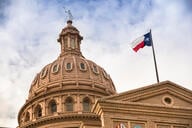You have /5 articles left.
Sign up for a free account or log in.
The Dalai Lama, who once said he would have been an engineer if he hadn’t become a monk, has been invited to speak at the annual meeting of the Society for Neuroscience, in November – to the distress of some society members who are boycotting the meeting.
According to the society, the Dalai Lama was invited because of growing interest in the neuroscience of meditation, but critics say a religious leader has no place at a scientific conference.
"This merger of serious neuroscience with a particular religion is a practical joke because the very recognition of the Dalai Lama relies on the belief in reincarnation," said Yi Rao, a neurology professor at Northwestern University. "That means that the mind and the body have to be separate for the mind to pass from one generation to another."
But society officials said that the Dalai Lama has carried on a dialogue with neuroscientists for 15 years. "It has been agreed that the talk will not be about religion or politics," said Carol Barnes, society president and professor of psychology and neurology at the University of Arizona. The talk will be the first in the "Dialogues between Neuroscience and Society” program, which will bring non-scientists to the annual meeting.
Interest in meditation research has grown, following an article that appeared in the Proceedings of the National Academy of Sciences last November. Advancements in brain imaging in the last decade have shown that connections among brain nerve cells can change throughout life. The study suggested that meditation, akin to sending your brain to the gym, can change the way the brain functions. In the study, Tibetan monks had more gamma wave activity, which is associated with perception and consciousness, than did novice meditators.
Richard Davidson, a neuroscientist at the University of Wisconsin at Madison, and lead investigator in the study, said he shares concern about the "slippery slope" of involving religion in science. However, he helped set up the talk by the Dalai Lama because it could "encourage increased attention to these domains of inquiry," which he thinks hold potential for improving health.
The Dalai Lama will not be wearing his “religious leader hat,” Davidson said, but rather his “public intellectual hat.” Like others who are excited to hear the Dalai Lama speak, Davidson thinks some of the backlash might be political. He noted that the many of the critics are of Chinese origin. The Dalai Lama fled Chinese soldiers in 1959 and has lived in India since then.
The angry scientists maintain their concern is not political, but professional. Rao said the society is “kidding itself” by suggesting the Dalai Lama “has insights about the mind because he meditates a lot,” he said. “If one can understand the neuroscience of meditation by meditating a lot, then one will understand the neuroscience of crying by crying a lot.”
Many scientists are somewhere in the middle on this debate. “I’m somewhat skeptical that it could be helpful or interesting,” said Joshua Berman, assistant professor of psychiatry at Columbia University. “I don’t think it would be terribly harmful either.” He added that he is not sure if inviting a religious leader will send the wrong message to the public.
Dani R. Smith, a researcher in the department of psychological and brain sciences at Johns Hopkins University, said a few people were “a bit surprised” to hear the Dalai Lama would appear. “I just thought it was a bit weird,” she said. “I just thought that’s one talk I might not attend. I could see the interest in wanting to have someone come and speak, but I don’t think the Dalai Lama would be the most qualified in this setting.”
Daniel Kahneman, a professor of psychology at Princeton University who has met the Dalai Lama, thinks his talk will be worthwhile because he presents a completely different view point, though that may be what some scientists are concerned about. “He doesn’t pretend to be a scientist, and no one will mistake him for one,” he said.
Some of the harshest critics have circulated a petition that chastises the society for blurring the lines between science and religion. Some of those scientists have already, or are considering withdrawing their own presentations. For the most part, though, scientists are taking a wait-and-see approach.
"Outraged? I’m not there yet," Smith said. "If it happened again next year, maybe I’d get there."




